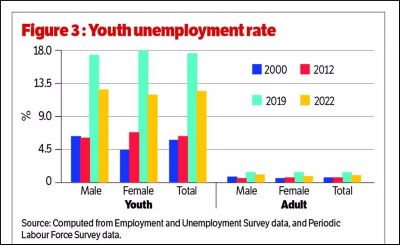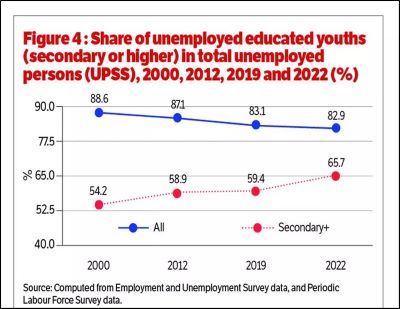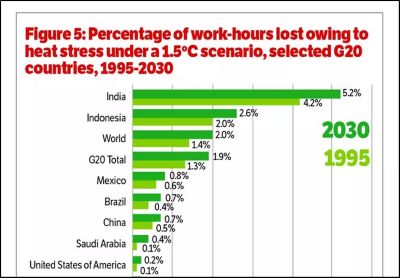Context-
India's employment landscape is facing significant challenges, including stagnant job growth, the threat of automation, and the impact of climate change on productivity. These issues have deep roots in the country's economic structure and pose formidable obstacles to achieving inclusive and sustainable growth.
Stagnant Employment Growth
● For the past two decades, India has grappled with stagnant employment growth, with rates hovering around 2 percent. This trend is concerning as it falls short of the necessary 4-5 percent required to absorb the surplus labor force. Despite efforts to spur job creation, particularly through economic liberalization and the rise of industries such as information technology (IT) and business process outsourcing (BPO), the pace of employment generation has remained sluggish.
● The predominance of informal employment, where over 90 percent of workers lack job tenure, exacerbates the challenge. Moreover, youth unemployment has emerged as a pressing issue, with rates rising steadily over the years as shown in Figure 3 and 4. The International Labour Organization (ILO) reports a threefold increase in youth unemployment from 2000 to 2019, reaching nearly 18 percent. This demographic, comprising 83 percent of the unemployed workforce, faces significant hurdles in accessing employment opportunities, especially those with higher education levels.
● Additionally, the informal sector continues to dominate India's employment landscape, with less than 20 percent engaged in regular wage or salaried occupations. This lack of formal employment opportunities not only contributes to income instability but also hampers access to social security benefits such as healthcare and retirement plans. Addressing the challenges of informal employment and youth unemployment requires comprehensive policy interventions aimed at promoting inclusive growth and expanding access to quality jobs.


Impact of Automation
● The threat of automation looms large over India's job market, particularly in sectors prone to technological disruption. High-tech industries, such as manufacturing and IT, are embracing automation to improve efficiency and reduce costs. However, this trend risks displacing human workers, especially in low-skilled service jobs that are susceptible to automation.
● While automation holds the promise of increased productivity, it also raises concerns about job polarization and inequality. Skilled workers may benefit from higher productivity and wages, but less-educated individuals could face unemployment or underemployment. Moreover, the rise of the gig economy, characterized by short-term contracts and precarious work conditions, further compounds the challenges faced by vulnerable workers.
Addressing Inequality and Education
● Tackling deep-rooted inequality is imperative for sustainable economic growth. The concentration of wealth among a few elite individuals constrains effective demand, hindering mass production and exacerbating unemployment and inequality. To address this, comprehensive measures are needed to promote inclusive growth, including redistributive policies and social safety nets.
● Investing in education is crucial for equipping individuals with the skills needed to thrive in a globalized economy. However, India's education system suffers from significant disparities, particularly between urban and rural areas. An overhaul of the education system is necessary to bridge these gaps and ensure equal access to quality education for all segments of society.
● Furthermore, enhancing vocational training and technical education programs can better align the skills of the workforce with the demands of the labor market. By fostering a culture of lifelong learning and skill development, India can empower its citizens to participate more fully in the economy and reduce inequality.
The Rise of a "Useless Class"
● As automation advances and effective demand declines, there is a risk of creating a "useless class" of structurally unemployable individuals. This scenario underscores the urgency of implementing schemes such as universal basic income to provide a safety net for those displaced by technological disruptions. Ensuring social protection and economic security for all citizens is essential for maintaining social cohesion and stability.
● Moreover, investing in job creation initiatives and entrepreneurship programs can help mitigate the impact of automation on employment. By fostering innovation and supporting small and medium-sized enterprises (SMEs), India can create new opportunities for economic participation and reduce dependence on traditional employment sectors. Additionally, promoting inclusive growth strategies that prioritize marginalized communities can help address disparities in access to employment and income.
Adapting to Climate Change
● Climate change poses additional challenges to India's labor force, particularly in sectors vulnerable to environmental hazards. Rising temperatures and extreme weather events threaten human productivity, leading to significant losses in working hours as shown in Figure 5. Agriculture, in particular, faces risks from heat stress, impacting the livelihoods of millions of farmers.

● Adopting carbon-displacing sustainable technologies is imperative for mitigating the adverse effects of climate change and safeguarding the well-being of workers. Transitioning to renewable energy sources and implementing eco-friendly practices can help reduce emissions and improve air and water quality. Moreover, investing in climate-resilient infrastructure and agricultural practices is essential for building adaptive capacity and ensuring the sustainability of livelihoods.
Conclusion
In conclusion, India's employment crisis is multifaceted, encompassing stagnant job growth, the threat of automation, and the impact of climate change. Addressing these challenges requires concerted efforts from government, industry, and civil society to promote inclusive and sustainable development. By prioritizing investments in education, social protection, and green technologies, India can create a resilient and equitable labor market that benefits all segments of society.
|
Probable Questions for UPSC Mains Exam- 1. How can India effectively address the dual challenge of stagnant job growth and rising youth unemployment, particularly in light of the predominance of informal employment and disparities in access to formal job opportunities? (10 Marks, 150 Words) 2. What policy interventions and strategies are needed to mitigate the adverse impacts of automation on employment, reduce inequality, and foster inclusive growth in India's rapidly evolving labor market? (15 Marks, 250 Words) |
Source- The Hindu Frontline







